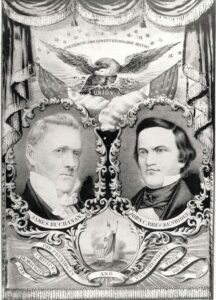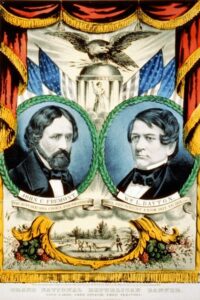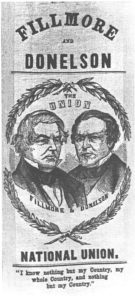The Presidential Election of 1856 was a heated election that pitted 3 candidates and parties against each other:
- Democratic Nominee: James Buchanan
- Republican Nominee: John C. Fremont
- Know-Nothing Nominee: Millard Fillmore
The central issue was slavery, with heated topics like the Kansas-Nebraska Act and Bleeding Kansas taking center stage. James Buchanan would win the election with 45% of the popular vote.
Jump to:
Presidential Election of 1856: Platforms
Democrats: They ran on a pro-slavery platform and advocated the Kansas-Nebraska Act. Their candidate was James Buchanan, who was a career politician born in the North but had southern sympathies.
Republicans: They ran on an anti-slavery platform and were formed in response to the passing of the Kansas-Nebraska Act. The party was made up of dissatisfied members of other parties and was in its infancy in 1856, but was beginning to gain momentum in the North. Their candidate, John C. Fremont, was from California, a new state.
Know-Nothing: More of the moderate party. Took a hard line on immigration, which was a secondary issue to the day. Former President Millard Fillmore was its nominee.
Presidential Election of 1856: Election Results
The election was a heated election that debated and tackled the issue of slavery, and by its end, it was clear that the nation was much more divided than even the most objective folks thought. It ended with James Buchanan winning the election but only taking 45% of the popular vote due to the Know-Nothings managing to muster 800,000 popular votes.
The Electoral Results were:
- James Buchanan - 174 (took all of the south plus Pennsylvania, Illinois, and Indiana)
- John C. Fremont - 114 (took most of the industrialized North)
- Millard Fillmore - 8 (Took Maryland)
James Buchanan became the President of a divided nation and a new party emerging. The Republicans would continue to gain power during his term.



Related Pages
- The History Junkie’s Guide to the Civil War
- The History Junkie’s Timeline of the Civil War
- The History Junkie’s Timeline of American History
- The History Junkie’s Guide to Colonial America
- The History Junkie’s Guide to the Revolutionary War
- Slavery during the American Revolution
- Return to The History Junkie's Homepage
